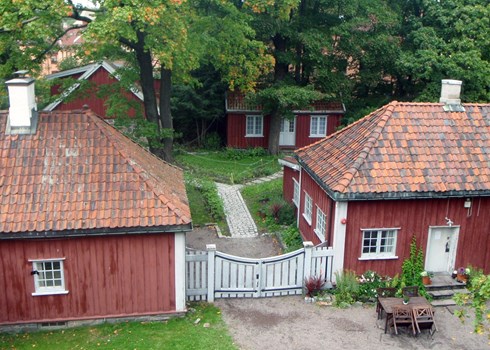

Owned by the National Trust of Norway since 1954.
From enclosed parcel of land in the city commons to an oasis in the city. In 1629, Christiania got its city commons where the city’s population could grow food and keep animals. This provided a valuable supplement to the food supply of Christiania from the city’s re-establishment after the great fire of 1624. Each property in the city was allocated a plot of land where grains and vegetables could be grown. Most of the city commons were intended as common grazing land, but private enclosed parcels of land were established in the common areas from an early stage. By enclosed parcel we mean a fenced-in piece of land. The property Vøienvolden was one of the large enclosed parcels of land that the wealthy and influential city councillor Johan Pettersen Bergmand was granted in 1683 for services rendered to the city.
New era with the Udnæs family. The property developed through many stages with many owners – city dwellers and farmers. In 1829, it was sold to distillery manager Gabriel J. Udnæs, and this marked the beginning of a new era at Vøienvolden. It became a meeting place for Haugeanism, a lay Christian movement that advocated church reform. His grandson Sverre Udnæs and his wife Ingrid took over the farm in 1913.
A major renovation project.The city had expanded towards Vøienvolden, which had given up land for the construction of new homes at Sagene. This was the end of Vøienvolden’s time as an active farm, having been run by Sverre Udnæs’ father for more than 40 years. Sverre and Ingrid Udnæs started a major renovation project and in 1917, they hired the architect Magnus Poulsson to redesign the main building. An extension facing the garden was torn down, and a new side wing with a kitchen and maid's room gave the building its present appearance.
The Oslo and Akershus branch of the National Trust of Norway has its offices at Vøienvolden and use the old farm at Sagene as a base for the trust’s activities.
Things to do in the area: In Vøienvolden’s immediate surroundings we find Maridalsveien, with preserved wooden buildings dating from the 18th and 19th centuries. This is an idyllic area where the Akerselva river leads the way to a rich industrial history. The nearby Labour Museum tells the story of the 19th-century industrial revolution along Akerselva, and there are guided walks of the area that include a visit to Vøienvolden. Vøienvolden is a tranquil and secluded place that is open to the general public, not far from the multitude of experiences available in the city. Visit Oslo
Sources: En reise gjennom norsk byggekunst. Ed. Terje Forseth. National Trust of Norway 1994/ Vøienvolden på Sagene. Fra gårdens og bydelens historie. Svein Solhjell. Pax Forlag A/S. 2017. Byløkker i Oslo. Løkker på bymarken. Finn Holden 2007
Opening hours
- Vøienvold is a nice hicking destination, free to visit the farm and gardens (exept at events)
Ticket prices
Visit us
Maridalsveien 1200461 Oslo


